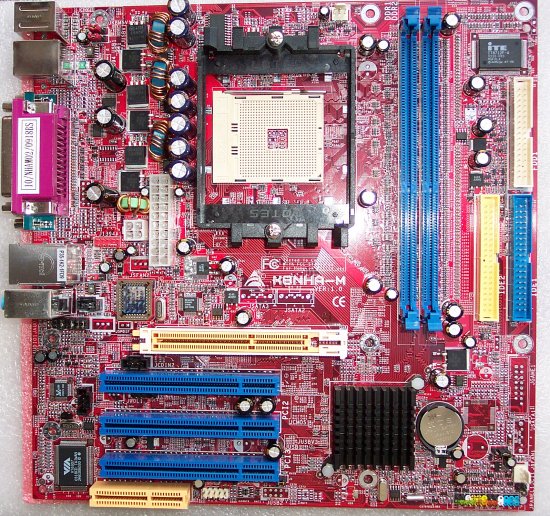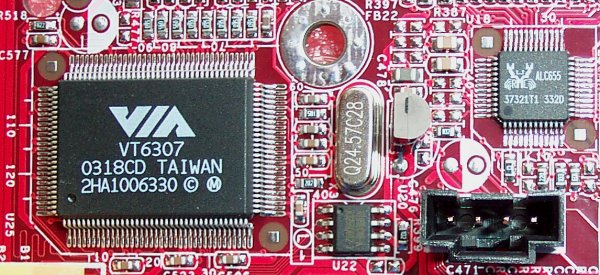K8NHA-M Layout and Features
The nForce3 150 (non-Pro) provides support for AMD's Clawhammer CPU. This 754-pin incarnation only boasts a single processor in its current lineup, the Athlon 64 3200+. That's perhaps the most distracting disadvantage with this new, powerful architecture. The barrier to the A64 club is price. We wish that AMD would introduce lower graded models in the range, along with cheaper prices. It's a decent CPU technically, but it's rather too expensive for most people's pockets.Biostar is ready and willing to produce A64-based boards, and a microATX version has already been announced and will be available shortly. The Biostar K8NHA-M is the nForce3 150 mATX motherboard

Switch back to the nForce2 motherboard and then look again at this model. There's obviously no hard-and-fast rule when it comes to motherboard layout. It's whatever fits the bill for the chipset and CPU, we guess. The Athlon 64 uses a retention bracket that's vaguely similar to a Pentium 4's. It positively dominates the middle section of the board. A backplate holds the screws in from the other side. Coolers can either attach via the screws or use their own clamping system. There's a single fan header close by the CPU socket and another on the lower right-hand extremity. With the board being within mATX dimensions of 244mm x 244mm, most coolers' fans will able to reach either header.

The Athlon 64 3200+ uses an on-die memory controller to great effect. NVIDIA chooses to forego a barren North Bridge and combine all the necessary functions into a single bridge located further down the board. This frees up key PCB real estate around the CPU socket area. Biostar decides that this is a prime area for locating the 20-pin and 4-pin power connectors. Apart from the routing issue, we can't quite see the logic. As with the nForce2 outfit, we'd much rather see the power plugs over by the IDE ports. Pulling wires over the CPU fan is never a good thing. A 3-phase power delivery system is in evidence here, too.
Whereas the nForce2 dual-channel memory controllers can, theoretically, push out 6.4GB/s at 200MHz memory clock, the single-channel Athlon 64 produces, wait for it, 3.2GB/s. It then gets complicated when you factor in that the CPU's on-die memory controller runs at full core speed, which is 2000MHz for the 3200+ model. The system memory speed is a divisor of clock speed, so DDR400 is simply one-tenth or /10 of clock speed. Two DIMM slots limit the maximum usable memory to 1GB unless you've got very deep pockets and can justify high-speed 1GB sticks.
The nForce3 150 single-chip solution continues to provide 8x AGP transfers. From a standard South Bridge's point of view, it's rather lacking. There's no on-chip SATA support, no APU, no FireWire or DualNET as found on the nF2 MCP-T. Therefore it was up to Biostar to add in the extras to this mATX board. There's no discrete support for SATA, though, but we can clearly see the ports silkscreened just below the model name.

In a twist of irony, VIA is chosen to provide FireWire support on the newest NVIDIA chipset. The VT6307 is a single-chip, 2-port FireWire (1394a) controller that's seen the light of day on a number of recent boards. It works, and it works well. A single port is attached to the I/O panel and the remaining port is available via a header on the board. That's sensible thinking. A number of cases use front-mounted or top-mounted ports.
The Realtek ALC655 is used as a conduit for the nForce3's software-accelerated sound. However, its 16-bit resolution doesn't tie in all that favourably with the 20-bit sound production. We'd take the ALC658 each and every time, and the ALC650 is better in terms of pure specification. Realtek is used to provide the PHY for LAN duties. The miniscule 8201BL chip, hiding just above the lockable AGP port, routes the chip's Ethernet abilities.
You just get the feeling that this is a budget board with, in parts, budget components. There's nothing wrong with that approach if the price is keen, and we now have the excellent AMD Athlon Model 3000+ available for £160.

Nothing new here. 4x USB2.0 and a single FireWire connection are obvious nods towards high-speed connectivity. Biostar keeps a number of older ports here, including Parallel and two Serial. S/PDIF inputs or outputs are conspicuous by their absence. The obvious shortcomings with the nForce3 150's features' set is plain to see. With on-chip SATA, motherboard manufacturers have to adopt SATA in some form. That's perhaps where VIA's K8T800 is better.









